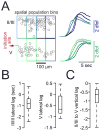Reliable and Elastic Propagation of Cortical Seizures In Vivo
- PMID: 28658617
- PMCID: PMC5551439
- DOI: 10.1016/j.celrep.2017.05.090
Reliable and Elastic Propagation of Cortical Seizures In Vivo
Abstract
Mapping the fine-scale neural activity that underlies epilepsy is key to identifying potential control targets of this frequently intractable disease. Yet, the detailed in vivo dynamics of seizure progression in cortical microcircuits remain poorly understood. We combine fast (30-Hz) two-photon calcium imaging with local field potential (LFP) recordings to map, cell by cell, the spread of locally induced (4-AP or picrotoxin) seizures in anesthetized and awake mice. Using single-layer and microprism-assisted multilayer imaging in different cortical areas, we uncover reliable recruitment of local neural populations within and across cortical layers, and we find layer-specific temporal delays, suggesting an initial supra-granular invasion followed by deep-layer recruitment during lateral seizure spread. Intriguingly, despite consistent progression pathways, successive seizures show pronounced temporal variability that critically depends on GABAergic inhibition. We propose an epilepsy circuit model resembling an elastic meshwork, wherein ictal progression faithfully follows preexistent pathways but varies flexibly in time, depending on the local inhibitory restraint.
Keywords: 4-AP; GABA; calcium; epilepsy; picrotoxin; seizure; two-photon.
Copyright © 2017 The Author(s). Published by Elsevier Inc. All rights reserved.
Conflict of interest statement
Figures






Comment in
-
Déjà Vu: Same Pattern of Neuron Activation From Seizure to Seizure, Only the Timing Changes.Epilepsy Curr. 2018 Mar-Apr;18(2):131-132. doi: 10.5698/1535-7597.18.2.131. Epilepsy Curr. 2018. PMID: 29643754 Free PMC article. No abstract available.
Similar articles
-
Preferential superficial cortical layer activation during seizure propagation.Epilepsia. 2025 Mar;66(3):929-941. doi: 10.1111/epi.18239. Epub 2024 Dec 24. Epilepsia. 2025. PMID: 39718688 Free PMC article.
-
GABAergic inhibition shapes interictal dynamics in awake epileptic mice.Brain. 2015 Oct;138(Pt 10):2875-90. doi: 10.1093/brain/awv227. Epub 2015 Aug 13. Brain. 2015. PMID: 26280596
-
Millimeter-scale epileptiform spike propagation patterns and their relationship to seizures.J Neural Eng. 2016 Apr;13(2):026015. doi: 10.1088/1741-2560/13/2/026015. Epub 2016 Feb 9. J Neural Eng. 2016. PMID: 26859260 Free PMC article.
-
Chronic invasive monitoring for identifying seizure foci in children.Neurosurg Clin N Am. 1995 Jul;6(3):491-504. Neurosurg Clin N Am. 1995. PMID: 7670323 Review.
-
Specific imbalance of excitatory/inhibitory signaling establishes seizure onset pattern in temporal lobe epilepsy.J Neurophysiol. 2016 Jun 1;115(6):3229-37. doi: 10.1152/jn.01128.2015. Epub 2016 Apr 13. J Neurophysiol. 2016. PMID: 27075542 Free PMC article. Review.
Cited by
-
Circuits generating secondarily generalized seizures.Epilepsy Behav. 2019 Dec;101(Pt B):106474. doi: 10.1016/j.yebeh.2019.106474. Epub 2019 Aug 17. Epilepsy Behav. 2019. PMID: 31431400 Free PMC article. Review.
-
Multimodal, Multiscale Insights into Hippocampal Seizures Enabled by Transparent, Graphene-Based Microelectrode Arrays.eNeuro. 2022 May 9;9(3):ENEURO.0386-21.2022. doi: 10.1523/ENEURO.0386-21.2022. Print 2022 May-Jun. eNeuro. 2022. PMID: 35470227 Free PMC article.
-
Multimodal Characterization of Seizures in Zebrafish Larvae.Biomedicines. 2022 Apr 20;10(5):951. doi: 10.3390/biomedicines10050951. Biomedicines. 2022. PMID: 35625689 Free PMC article.
-
WONOEP appraisal: Network concept from an imaging perspective.Epilepsia. 2019 Jul;60(7):1293-1305. doi: 10.1111/epi.16067. Epub 2019 Jun 9. Epilepsia. 2019. PMID: 31179547 Free PMC article. Review.
-
A simple model of epileptic seizure propagation: Potassium diffusion versus axo-dendritic spread.PLoS One. 2020 Apr 10;15(4):e0230787. doi: 10.1371/journal.pone.0230787. eCollection 2020. PLoS One. 2020. PMID: 32275724 Free PMC article.
References
-
- Avoli M, D’Antuono M, Louvel J, Kohling R, Biagini G, Pumain R, D’Arcangelo G, Tancredi V. Network and pharmacological mechanisms leading to epileptiform synchronization in the limbic system in vitro. Prog Neurobiol. 2002;68:167–207. - PubMed
Publication types
MeSH terms
Grants and funding
LinkOut - more resources
Full Text Sources
Other Literature Sources
Medical

